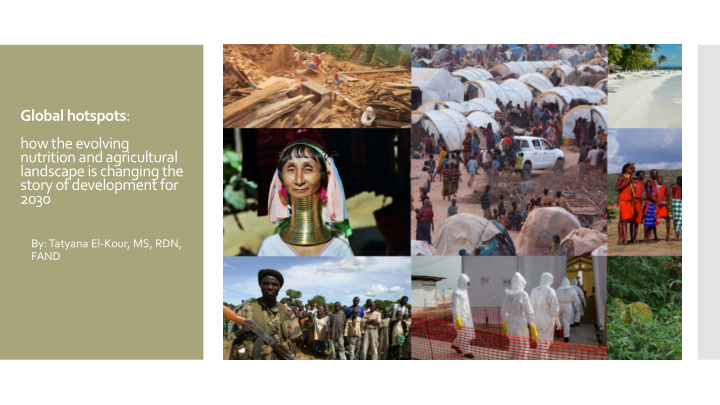



Global hotspots : how the evolving nutrition and agricultural landscape is changing the story of development for 2030 By: Tatyana El-Kour, MS, RDN, FAND
• I currently work as a Nutrition Coordinator for Action Against Disclaimer Hunger - Lebanon • I received partial funding from the Hunger and Environmental Nutrition Practice Group of the Academy of Nutrition and Dietetics. Tatyana El-Kour, MS, RDN, FAND • No material within this presentation may be copied, in any form, for public, private, or commercial use without prior approval.
Identify and prioritize hunger, malnutrition, and nutrition security hotspots where food and nutrition policy and agricultural development meet to inspire social action on realizing the Sustainable Development Goals. Describe trends, drivers, and challenges of the global agricultural Objectives landscape in the emerging development context. Discuss the impact of evidence-informed worldview on changing population behavior towards food, nutrition and agricultural policy choices and actions within everyday practice.
How many people are there in the world? a. 8 Billion Quiz # 1 b. 7 Billion c. 6 Billion
What is the number of hungry people in the world? a. 1 billion Quiz # 2 b. 800 million c. 700 million
What percentage of the world population is hungry? a. 6.25 % (about 1/16 th of the World Population) Quiz # 3 b. 11 % (about 1/9 th of the World Population) c. 25 % (about 1/4 th of the World Population)
In the last 20 In the last 20 years, the proportion of the years the world population living in extreme poverty proportion of has: the World population Almost doubled living in Remained more or less the same extreme Almost halved poverty has...
In the last 20 years the Almost doubled proportion of the World Remained more or less the same population living in Almost halved extreme poverty has...
Over the last 200 years, poverty rate fell continuously coupled with 7-fold increase in world population Every day 250,000 people graduate from extreme poverty + 300,000 get electricity for the first time + 250,000 get access to clean water (worldbank.org)
The decline of global poverty
2030: year of zero-hunger
Mapping progress towards eradicating world hunger Global Hunger Index, 2016
Mapping progress towards eradicating world hunger Per map, the higher the score, the larger the circle size. The African region has the greatest number and size of circles indicating highest hunger scores.
Under-5 Mortality Rate The African region has the highest number of labels and possesses the greatest under-5 mortality rates
The stunting rate of children under 5 years of age (%)
The stunting rate of children under 5 years of age (%)
Poverty Conflict Key drivers of World population hunger Food and agriculture policy Climate change
Trends in World agricultural production
Trends in Per Capita Food Production
200 180 160 Trends in per 140 capita food 120 production 100 80 The developing country 60 regions have not all made equal progress 70 75 80 85 90 95 00 04 Asia and the Pacific Near East and North Africa Sub-Saharan Africa Latin America and the Caribbean
Million tonnes 2050 2000 Production World cereal 1950 Utilization production 1900 has 1850 picked up 1800 1750 1700 90/91 92/93 94/95 96/97 98/99 00/01 02/03 04/05 05/06*
Food shortages in the Greater Horn of Africa, including South Sudan, Somalia, and Yemen
Billion US$ 14 The 12 agricultural 10 trade deficit of 8 Least 6 4 Developed 2 Countries is 0 widening 61 65 69 73 77 81 85 89 93 97 01 03 total agricultural exports total agricultural imports
Link between agricultural and rural development and food security Countries with worsening levels of undernourishment have seen a declining agricultural GDP
Processes are needed to address complexity and multi- sectoral approaches
Goal 2. End hunger, By 2030 end all forms of malnutrition , achieve food including achieving by 2025 the security and internationally agreed targets on stunting improved and wasting in children under five years of nutrition, and age, and address the nutritional needs of promote adolescent girls, pregnant and lactating sustainable women, and older persons. agriculture
Business as usual will not work
Refugees queue for food parcels in Yarmouk, Syria. Photograph: Reuters
Context Matters
Tracking population movement
Typhoon Haiyan – You are Syrian Refugees in Contextual Philippines 2013 Amman, Jordan, 2011- present relevance and here impact Ebola epidemic Sierra Leone, Liberia, Guinea 2013-2015 Conflict IDP and food security Sahel Food insecurity crisis South Sudan 2013- 2011-present present
Mapping hunger, malnutrition, nutrition security hotspots using geographic information systems Linking agricultural development to improving food and nutrition security Trends, drivers, and challenges of agricultural development, including: global population, income, food consumption patterns, Key topics food supply chain, prices of agricultural commodities, food shortages and food emergencies covered Implications of agricultural development on meeting the Zero Hunger Challenge with emphasis on contribution to cross-cutting issues and multi-sectoral action Application of evidence-informed facts in the context of population behavior change
“ Amid horror, there are sparks of joy and moments of life and sharing that we do our best every day to make them happen ,”
The world is evolving and professionals/educators’ perceptions need to evolve with it. There is dire need to know the facts of the past in the context of Key Take shaping the story of the future for realizing the Sustainable Home Development Goals. Knowledge alone is not enough. There are new skills, features and Messages behaviors to possess for driving population engagement through data and emerging media.
Recommend
More recommend